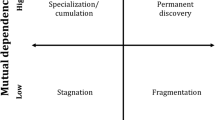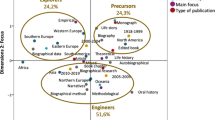Abstract
The intellectual landscapes of the humanities are mostly uncharted territory. Little is known on the ways published research of humanist scholars defines areas of intellectual activity. An open question relates to the structural role of core literature: highly cited sources, naturally playing a disproportionate role in the definition of intellectual landscapes. We introduce four indicators in order to map the structural role played by core sources into connecting different areas of the intellectual landscape of citing publications (i.e. communities in the bibliographic coupling network). All indicators factor out the influence of degree distributions by internalizing a null configuration model. By considering several datasets focused on history, we show that two distinct structural actions are performed by the core literature: a global one, by connecting otherwise separated communities in the landscape, or a local one, by rising connectivity within communities. In our study, the global action is mainly performed by small sets of scholarly monographs, reference works and primary sources, while the rest of the core, and especially most journal articles, acts mostly locally.






Similar content being viewed by others
Notes
Analyses relied on igraph [0.7.1] (Csardi and Nepusz 2006) and Vincent Traag’s community detection library [0.5.3] available at https://github.com/vtraag/louvain-igraph.
See http://wiki.cns.iu.edu/display/CISHELL/Detect+Duplicate+Nodes, accessed May 2017.
References
Ahlgren, P., Pagin, P., Persson, O., & Svedberg, M. (2015). Bibliometric analysis of two subdomains in philosophy: Free will and sorites. Scientometrics, 103(1), 47–73.
Ardanuy, J. (2013). Sixty years of citation analysis studies in the humanities (1951–2010). Journal of the American Society for Information Science and Technology, 64(8), 1751–1755.
Barabási, A. L. (2016). Network science. Cambridge: Cambridge University Press.
Barrett, A. (2005). The information-seeking habits of graduate student researchers in the humanities. The Journal of Academic Librarianship, 31(4), 324–331.
Bastian, M., Heymann, S., & Jacomy, M. (2009). Gephi: An open source software for exploring and manipulating networks. In: International AAAI conference on weblogs and social media.
Blondel, V. D., Guillaume, J. L., Lambiotte, R., & Lefebvre, E. (2008). Fast unfolding of communities in large networks. Journal of Statistical Mechanics: Theory and Experiment, 10, P10,008.
Boyack, K. W., Klavans, R., & Börner, K. (2005). Mapping the backbone of science. Scientometrics, 64(3), 351–374.
Börner, K. (2010). Atlas of science: Visualizing what we know. Cambridge, Mass: MIT Press.
Börner, K., & Scharnhorst, A. (2009). Visual conceptualizations and models of science. Journal of Informetrics, 3(3), 161–172.
Börner, K., Chen, C., & Boyack, K. W. (2003). Visualizing knowledge domains. Annual Review of Information Science and Tec hnology, 37(1), 179–255.
Chi, P. S. (2016). Differing disciplinary citation concentration patterns of book and journal literature? Journal of Informetrics, 10(3), 814–829.
Colavizza, G. (2017). The core literature of the historians of Venice. Frontiers in Digital Humanities, 4, 14.
Colavizza G., Romanello, M., & Kaplan, F. (2017). The references of references: A method to enrich humanities library catalogs with citation data. International Journal on Digital Libraries, 1–11. https://doi.org/10.1007/s00799-017-0210-1.
Coscia, M., & Schich, M. (2011). Exploring co-occurrence on a meso and global level using network analysis and rule mining. San Diego.
Csardi, G., & Nepusz, T. (2006). The igraph software package for complex network research. InterJournal Complex Systems, 1695. http://igraph.org.
Cullars, J. (1992). Citation characteristics of monographs in the fine arts. The Library Quarterly, 62(3), 325–342.
Engels, T. C. E., Ossenblok, T. L. B., & Spruyt, E. H. J. (2012). Changing publication patterns in the social sciences and humanities, 2000–2009. Scientometrics, 93(2), 373–390.
Finkenstaedt, T. (1990). Measuring research performance in the humanities. Scientometrics, 19(5–6), 409–417.
Fortunato, S., & Hric, D. (2016). Community detection in networks: A user guide. Physics Reports, 659, 1–44.
Garfield, E. (1980). Is information retrieval in the arts and humanities inherently different from that in science? The effect that ISI®’s citation index for the arts and humanities is expected to have on future scholarship. The Library Quarterly, 50(1), 40–57.
Glänzel, W., & Schoepflin, U. (1999). A bibliometric study of reference literature in the sciences and social sciences. Information Processing & Management, 35(1), 31–44.
Hammarfelt, B. (2011). Interdisciplinarity and the intellectual base of literature studies: Citation analysis of highly cited monographs. Scientometrics, 86(3), 705–725.
Hammarfelt, B. (2012). Harvesting footnotes in a rural field: Citation patterns in Swedish literary studies. Journal of Documentation, 68(4), 536–558.
Hammarfelt, B. (2016). Beyond coverage: Toward a bibliometrics for the humanities. In M. Ochsner, S. E. Hug, & H. D. Daniel (Eds.), Research assessment in the humanities (pp. 115–131). Cham: Springer International Publishing.
Heinzkill, R. (2007). References in scholarly English and American literary journals thirty years later: A citation study. College & Research Libraries, 68(2), 141–154.
Hellqvist, B. (2009). Referencing in the humanities and its implications for citation analysis. Journal of the American Society for Information Science and Technology, 61(2), 310–318.
Hicks, D. (1999). The difficulty of achieving full coverage of international social science literature and the bibliometric consequences. Scientometrics, 44(2), 193–215.
Hicks, D. (2004). The four literatures of social science. In H. F. Moed, W. Glänzel, & U. Schmoch (Eds.), Handbook of quantitative science and technology research (pp. 473–496). Berlin: Springer.
Hitchcock, T. (2013). Confronting the digital: Or how academic history writing lost the plot. Cultural and Social History, 10(1), 9–23.
Huang, Mh, & Yw, Chang. (2008). Characteristics of research output in social sciences and humanities: From a research evaluation perspective. Journal of the American Society for Information Science and Technology, 59(11), 1819–1828.
Hérubel, J. P. V. M. (1994). Citation studies in the humanities and social sciences: A selective and annotated bibliography. Collection Management, 18(3–4), 89–137.
Hérubel, J. P. V. M., & Goedeken, E. A. (2001). Using the arts and humanities citation index to identify a community of interdisciplinary historians: An exploratory bibliometric study. The Serials Librarian, 41(1), 85–98.
Jacomy, M., Venturini, T., Heymann, S., & Bastian, M. (2014). ForceAtlas2, a continuous graph layout algorithm for handy network visualization designed for the Gephi software. PLoS ONE, 9(6), e98,679.
Jones, C., Chapman, M., & Woods, P. C. (1972). The characteristics of the literature used by historians. Journal of Librarianship and Information Science, 4(3), 137–156.
Klavans, R., & Boyack, K. W. (2009). Toward a consensus map of science. Journal of the American Society for Information Science and Technology, 60(3), 455–476.
Knievel, J. E., & Kellsey, C. (2005). Citation analysis for collection development: A comparative study of eight humanities fields. The Library Quarterly, 75(2), 142–168.
Kolasa, W. M. (2012). Specific character of citations in historiography (using the example of Polish history). Scientometrics, 90(3), 905–923.
Kreuzman, H. (2001). A co-citation analysis of representative authors in philosophy: Examining the relationship between epistemologists and philosophers of science. Scientometrics, 50(3), 525–539.
Larivière, V., Archambault, É., Gingras, Y., & Vignola-Gagné, É. (2006a). The place of serials in referencing practices: Comparing natural sciences and engineering with social sciences and humanities. Journal of the American Society for Information Science and Technology, 57(8), 997–1004.
Larivière, V., Gingras, Y., & Archambault, É. (2006b). Canadian collaboration networks: A comparative analysis of the natural sciences, social sciences and the humanities. Scientometrics, 68(3), 519–533.
Leydesdorff, L., & Salah, A. (2010). Maps on the basis of the Arts & Humanities Citation Index: The journals Leonardo and Art Journal versus “digital humanities” as a topic. Journal of the Association for Information Science and Technology, 61(4), 787–801.
Leydesdorff, L., Hammarfelt, B., & Salah, A. (2011). The structure of the Arts & Humanities Citation Index: A mapping on the basis of aggregated citations among 1157 journals. Journal of the American Society for Information Science and Technology, 62(12), 2414–2426.
Lin, C. S., Chen, Y. F., & Chang, C. Y. (2013). Citation functions in social sciences and humanities: Preliminary results from a citation context analysis of Taiwan’s history research journals. Proceedings of the American Society for Information Science and Technology, 50(1), 1–5.
Lindholm-Romantschuk, Y., & Warner, J. (1996). The role of monographs in scholarly communication: An empirical study of philosophy, sociology and economics. Journal of Documentation, 52(4), 389–404.
Linmans, A. J. M. (2009). Why with bibliometrics the humanities does not need to be the weakest link: Indicators for research evaluation based on citations, library holdings, and productivity measures. Scientometrics, 83(2), 337–354.
McCain, K. W. (1987). Citation patterns in the history of technology. Library & Information Science Research, 9, 41–59.
Merton, R. K. (1968). The Matthew effect in science. Science, 159(3810), 56–63.
Mingers, J., & Leydesdorff, L. (2015). A review of theory and practice in scientometrics. European Journal of Operational Research, 246(1), 1–19.
Mongeon, P., & Paul-Hus, A. (2015). The journal coverage of Web of Science and Scopus: A comparative analysis. Scientometrics, 106(1), 213–228.
Nederhof, A. J. (2006). Bibliometric monitoring of research performance in the social sciences and the humanities: A review. Scientometrics, 66(1), 81–100.
Newman, M. E. J. (2010). Networks: An introduction. Oxford: Oxford University Press.
Newman, M. E. J., & Girvan, M. (2004). Finding and evaluating community structure in networks. Physical Review E, 69(2), 026113.
Nolen, D. S., & Richardson, H. A. (2016). The search for landmark works in English literary studies: A citation analysis. The Journal of Academic Librarianship, 42(4), 453–458.
Olensky, M., Schmidt, M., & van Eck, N. J. (2016). Evaluation of the citation matching algorithms of CWTS and iFQ in comparison to the Web of science. Journal of the Association for Information Science and Technology, 67(10), 2550–2564.
Perianes-Rodriguez, A., Waltman, L., & van Eck, N. J. (2016). Constructing bibliometric networks: A comparison between full and fractional counting. Journal of Informetrics, 10(4), 1178–1195.
Persson, O. (1994). The intellectual base and research fronts of “JASIS” 1986–1990. Journal of the American Society for Information Science, 45(1), 31.
Romanello, M. (2016). Exploring citation networks to study intertextuality in classics. Digital Humanities Quarterly, 10(2), 1–12.
Romanello, M., & Colavizza, G. (2017). dhlab-epfl/LinkedBooksMonographs: LinkedBooksMonographs (version 1.1). https://doi.org/10.5281/zenodo.377047.
Sci2 Team. (2009). Science of Science (Sci2) Tool. Indiana University and SciTech Strategies. https://sci2.cns.iu.edu.
Šubelj, L., van Eck, N. J., & Waltman, L. (2016). Clustering scientific publications based on citation relations: A systematic comparison of different methods. PLOS ONE, 11(4), e0154,404.
Thompson, J. W. (2002). The death of the scholarly monograph in the humanities? Citation patterns in literary scholarship. Libri, 52(3), 121–136.
Waltman, L. (2016). A review of the literature on citation impact indicators. Journal of Informetrics, 10(2), 365–391.
Watson-Boone, R. (1994). The information needs and habits of humanities scholars. Reference Quarterly, 34(2), 203–215.
Weingart, S. B. (2015). Finding the history and philosophy of science. Erkenntnis, 80(1), 201–213.
Wiberley, S. E., Jr. (2010). Humanities literatures and their users. In Encyclopedia of library and information sciences (pp. 2197–2204).
Williams, P., Stevenson, I., Nicholas, D., Watkinson, A., & Rowlands, I. (2009). The role and future of the monograph in arts and humanities research. Aslib Proceedings, 61(1), 67–82.
Zuccala, A., Guns, R., Cornacchia, R., & Bod, R. (2015). Can we rank scholarly book publishers? A bibliometric experiment with the field of history. Journal of the Association for Information Science and Technology, 66(7), 1333–1347.
Acknowledgements
I would like to thank, in alphabetical order: Martina Babetto, Silvia Ferronato and Matteo Romanello (EPFL), colleagues who helped with the collection and processing of the Venetian dataset. The Library of the Ca’ Foscari University of Venice willingly collaborated with bibliographical resources and logistics support. The Central Institute for the Union Catalogue of Italian Libraries and Bibliographic Information (ICCU) shared its catalog metadata with us. I thank both for their support. I would also like to thank Ludo Waltman and Vincent Traag (CWTS Leiden), and Massimo Franceschet (University of Udine) for very helpful advice. I worked in part on this research project during a research stay at the Centre for Science and Technology Studies (CWTS) at Leiden University, where I had the opportunity to present and discuss my work with great benefits. I would finally like to thank CWTS for providing access to its databases.
Author information
Authors and Affiliations
Corresponding author
Additional information
This research is funded by the Swiss National Fund with Grants 205121_159961 and P1ELP2_168489.
Rights and permissions
About this article
Cite this article
Colavizza, G. The structural role of the core literature in history. Scientometrics 113, 1787–1809 (2017). https://doi.org/10.1007/s11192-017-2550-4
Received:
Published:
Issue Date:
DOI: https://doi.org/10.1007/s11192-017-2550-4




